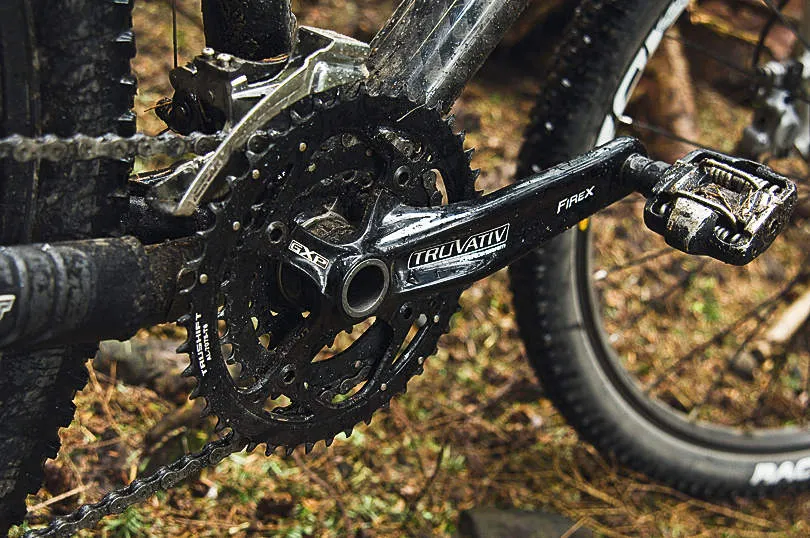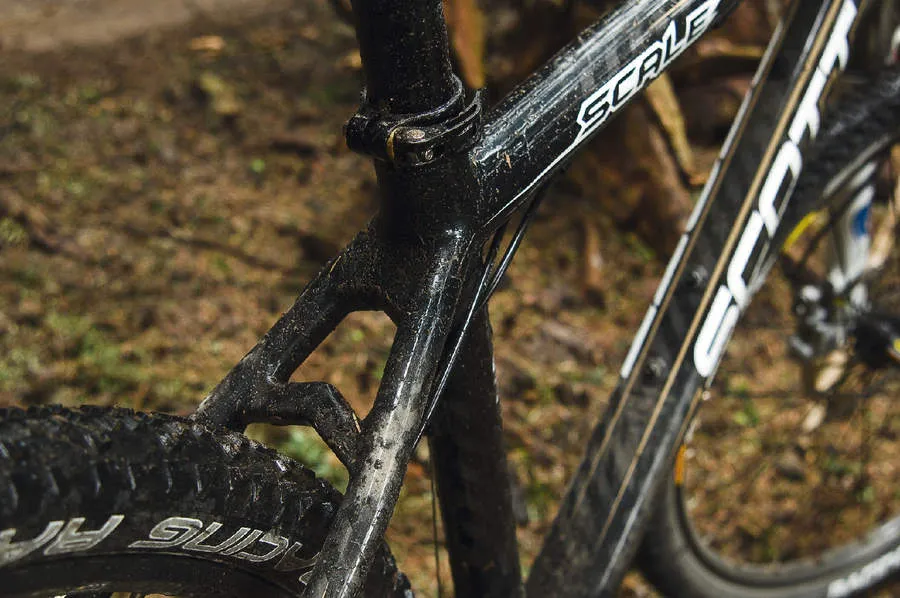As focused a race bike as they come, Scott’s Scale is pure of purpose and quick of pace. If you’re weighing your chances for your next cross-country race, you need a Scale.
Scott has been trimming the fat from its Scale hardtails, resulting in what may be the lightest off-the-peg carbon race bikes around at a given price. Lightness helps you climb – up the hill and on to the podium.
Ride & handling: climb-stormingly fast
For a 23lb bike with a 100mm fork, the Scott descends well. Yet it’s still a light, short-travel hardtail, and trail turbulence is always going to be a factor. Because you don’t have the inertia of a bigger bike to carry you through, you’re going to experience a bit of bobble. However, if you set up the Scott’s sweet Fox fork just so and can find your flow, it’ll get you down fine.
Where the Scott excels is going up: it’s an awesome climber. It confidently scrabbled up a sandy root-interrupted climb that the other bikes balked on, and went up everything at least one gear higher. Some of that is physical: it simply is lighter. Much of it is psychological. Because you’re on a lighter bike, you attack climbs with more zest.
On flatter terrain, the benefit of the Scott’s light weight isn’t that it’s faster when you’re rolling, but that it’s easier to get up to speed – whether you’re setting off from a standing start or coming out of a corner.
It copes with hardpacked singletrack better than armoured trails, which eat into its momentum. Corrugations kick you about a bit too, despite carbon’s absorbent qualities. This fatigues the muscles, and I ended a 24-mile loop with mild backache (but a personal best time). At least you don’t climb off feeling like you’ve been kidney-punched like you do with harsh aluminium hardtails.
Frame: light & tight
The Scale 30 uses the same HMF composite frame as the more expensive 20 and 15 models, and it weighs in at around a kilo – that’s road bike light. Won’t it just crumple if a big rider gets on it and gives it some welly? It shouldn’t: the maximum recommended rider weight is a generous 17 stone.
The Scott frame is bonded together from carbon fibre tubes rather than coming straight out of a single mould, monocoque style. The claimed advantage is a better strength-to-weight ratio.
Compared with a light aluminium frame you’re saving weight (up to half a kilo) and also gaining superior fatigue life. When carbon does fail, it fails catastrophically, but repeated loads from regular riding that aren’t enough to snap it won’t hurt it. Like steel and titanium (but unlike aluminium), carbon can flex without cracking.
None of these frames has room for tyres much bigger than the 2.1in fitted. That’s particularly true of the Scott where, if it were muddy, you’d want to go down to 1.8in tyres to provide room for the slop to splatter through.
Equipment: good gear with room for gram-trimming
The light Fox 32 F100RL complements the frame well, and its bump-eating performance is ample for cross-country courses. When you can ride on the wheel of a couple of five-inch full-sussers going downhill, like we did, the fork must be doing something right.
It’s only a shame there’s no remote lockout; if you hit a bump when you’re trying to lock the fork prior to making your jump, it’s alarming just how close you can come to putting your hand in the wheel…
The flat bar suits the character of the bike well. If anything, it’s not old-school cross-country enough: some bling carbon bar ends would add hardly any weight and would give you something to haul on better when you’re charging uphill.
The drivetrain is mostly Shimano Deore LX, with a splash of Deore XT in the form of a Shadow rear mech. It’s all good. If you want to trim some weight for free, take off the inner chainring – a 32-tooth chainring will get you up anything at race pace.
More grams could go by swapping the quick-release seat binder for an Allen bolt. You’re not going to fart about with your seatpost in a race, after all.
The wheels, meanwhile, are pretty svelte already. Mavic Crossride disc wheels have 24 spokes apiece. If you do break a spoke it will put your wheel further out of whack than when you’re on 32s, but that’s a worthwhile trade off for weight when you’re racing.
The Racing Ralph tyres are our favourites among the rubber on recent cross-country hardtails. As well as being nice and light (470g each), the tread is an excellent compromise between reasonable cross-country grip and good rolling performance.
The Avid Juicy Fives here get even more braking bite from a 185mm front rotor. On a trail bike, that would be a bonus. Bigger riders might like it anyway on the Scott. If you’re under 11 stone or so it would be tempting to save even more weight and run a 160mm front rotor and a 140mm rear.






